
- Enteral nutrition is administered through a feeding tube that is introduced in either of these ways:
- through the nose to the stomach or small intestine (nasal tube),
- through the mouth to the stomach or small intestine (oral tube),
- through an ostomy or a stoma, a small opening in the skin that connects the stomach or small intestine to the belly wall. A tube or button is installed in the stoma to keep it open for feeding.
- The nasal (or naso-enteric) tube is a long, thin,
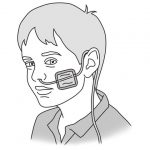 flexible tube inserted into a nostril, running down the back of the throat (into the pharynx) to the esophagus and then into the stomach and small intestine (if necessary). The nasal tube is usually used over a short period of time (a few days to several weeks) to try enteral nutrition, to supplement food taken by mouth or to administer medication. The nasal tube can be inserted and removed after each feeding session or left in place, depending on the child’s condition.
flexible tube inserted into a nostril, running down the back of the throat (into the pharynx) to the esophagus and then into the stomach and small intestine (if necessary). The nasal tube is usually used over a short period of time (a few days to several weeks) to try enteral nutrition, to supplement food taken by mouth or to administer medication. The nasal tube can be inserted and removed after each feeding session or left in place, depending on the child’s condition.
TYPES OF NASAL TUBES
Nasogastric tube

- Tube inserted into a nostril and advanced down the throat to the esophagus and then the stomach.
- Frequently used for home enteral nutrition.
- Allows feeding and medication to be administered directly into the stomach.
- Can be installed and replaced by the parent, depending on the child’s condition and if they have been taught by the healthcare team.
Nasoduodenal tube
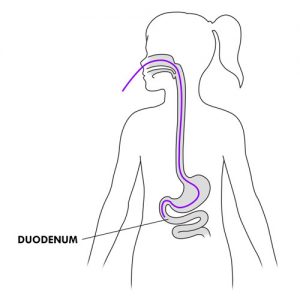
- Tube inserted into a nostril and advanced down the throat to the esophagus, the stomach and then to the first part of the small intenstine (duodenum).
- Allows feeding directly into the duodenum (bypassing the stomach).
- Allows the administration of medication directly into the duodenum, as needed.
- Can only be installed and replaced by the healthcare team.
Nasojejunal tube

- Tube inserted through a nostril and advanced down the throat to the esophagus, the stomach and then to the second part of the small intestine (jejunum).
- Allows feeding directly into the jejunum.
- Allows medication to be administered directly into the jejunum, as needed.
- Can only be installed and replaced by the healthcare team.
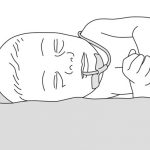
- The oral tube is a long, thin, flexible tube inserted into the mouth, directed to the back of the throat (in the pharynx) and then advanced down the esophagus into the stomach(orogastric tube) or the second part of the small intestine (jejunum) (orojejunal tube). This type of tube is installed by the healthcare team for use exclusively in the hospital.
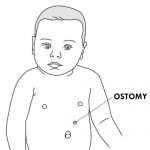 When food is to be administered directly into the stomach or small intestine, an opening must be made in the belly to install a tube. The opening is called a stoma. When the stoma is made in the stomach, it is called a gastrostomy. When the stoma is made in the small intestine, it is placed in the second part (jejunum); this is called a jejunostomy. In general, a stoma is used for comfort and safety reasons if:
When food is to be administered directly into the stomach or small intestine, an opening must be made in the belly to install a tube. The opening is called a stoma. When the stoma is made in the stomach, it is called a gastrostomy. When the stoma is made in the small intestine, it is placed in the second part (jejunum); this is called a jejunostomy. In general, a stoma is used for comfort and safety reasons if:
- enteral feeding must be administered over a long period of time (several months to several years), and/or
- it is not possible to insert a tube through the child’s nose, mouth, throat or esophagus, and/or
- the child vomits frequently, which may cause the nasal tube to move and require frequent reinsertion.
- The gastrostomy and jejunostomy allow an enterostomy feeding tube to be placed through the stoma. It can be a button (or low-profile tube or skin-level device) or a long tube. This equipment is available in different models and sizes.
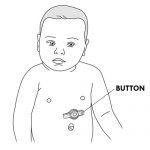

NEVER INSTALL OR REPLACE THE BUTTON OR LONG TUBE IF YOUR CHILD HAS A STOMA FOR LESS THAN 6 TO 8 WEEKS (or other length of time as recommended by your healthcare team) as the stoma is not fully healed; all re-insertions in this time period are the responsibility of your healthcare team.
- A feeding button is a specific device that is installed in a stoma and consists of two connected parts:
- an external (outside) part, flattened in shape, visible at the level of the belly, composed of:
- a balloon port with a fill valve (for balloon button models),
- a feeding and medication port to fit an extension set,
- a port cover to close the feeding and medication port when it is not being used,
- an anti-reflux valve to prevent the stomach or intestinal contents from flowing back up through the button when connecting or disconnecting the extension set.
- an internal (inside) part in the stomach or small intestine, composed of:
- a stem that passes through the belly skin to the stomach or small intestine and is open at the end to allow the formula to pass through,
- an internal bolster (or internal retention device) (eg, a balloon containing water, mushroom, dome) to hold the button to the wall of the stomach or intestine and prevent it from moving.
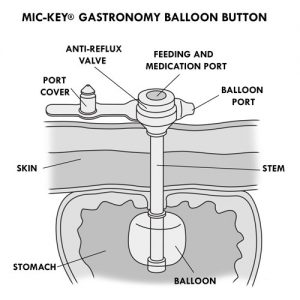
TYPES OF FEEDING BUTTONS
Gastrostomy button
(eg, Mic-Key™, AMT MiniONE™, NutriPort™, Bard™, EntriStar™)
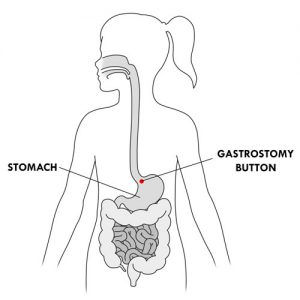
- Device installed in a gastrostomy.
- Allows feeding and medication administration directly into the stomach.
- Can be installed and replaced by the parent only after 6 to 8 weeks after surgery (or other length of time as recommended by your healthcare team), if the model is balloon button and the parent has been taught this skill; non-balloon button models must be replaced by the healthcare team.
Gastrojejunal button
(eg, Mic-Key™J, AMT G-JET™)
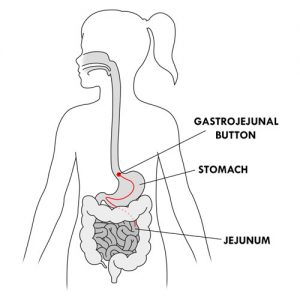
- Device installed in a gastrostomy that extends through a tube from the stomach to the jejunum.
- Has two entry ports: one into the stomach (usually used for medications) and the second into the jejunum (usually used for continuous feeding).
- Mostly used in children who cannot be fed directly into the stomach.
- Can only be replaced by the healthcare team.
Jejunostomy button
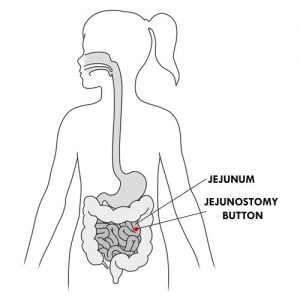
- Device installed in a jejunostomy.
- Allows feeding directly into the jejunum.
- Allows medication administration directly into the jejunum, as recommended by the healthcare team.
- Mostly used in children who cannot be fed directly into the stomach.
- Can only be replaced by the healthcare team. If the healthcare team allows the parent to change the button, they provide the necessary training.
- An extension set (or feed extension set) must be connected to the button through the feeding port to administer feeding or medication. It is a long tube, consisting of several pieces:
- a large feeding port,
- a junction with a small medication port (present in some models for continuous feeding),
- a cover for each of these ports (to close them outside of administration periods),
- a clamp,
- a connector to connect the extension set to the button.
Each type of button has its own extension set.

- A long enterostomy feeding tube is a long flexible tube that is installed in a stoma and consists of two connected parts:
- an external (outside) part visible at the level of the belly, composed of:
- an external bolster (or external retention device) to stabilize the tube at skin level (eg, retention ring),
- a balloon port with its fill valve (for balloon tube models),
- a feeding port,
- a medication port (in some models),
- a port cover attached to each of these ports allowing them to be closed outside of administration periods.
- an internal (inside) part in the stomach or small intestine, composed of:
- an internal bolster (or internal retention device) (eg, a balloon containing water, mushroom, dome, etc.) to hold the tube to the wall of the stomach or intestine and prevent it from moving,
- an opening at the end of the tube to allow the nutritional formula to pass through.
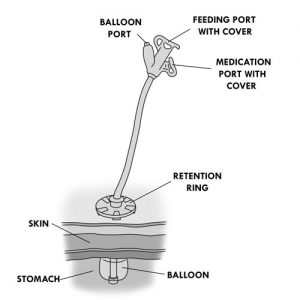
TYPES OF LONG ENTEROSTOMY FEEDING TUBES
Gastrostomy tube

- Flexible tube inserted into the stomach through a gastrostomy.
- Allows feeding and medication administration directly into the stomach.
- Can be installed and replaced by the parent only after 6 to 8 weeks after surgery (or other length of time as recommended by your healthcare team), if the model has a balloon and the parent has been taught this skill; non-balloon tube models can only be replaced by the healthcare team.
Gastrojejunal tube
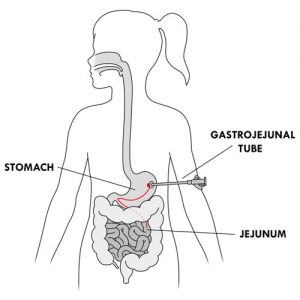
- Flexible tube inserted into the stomach through a gastrostomy and which goes into the jejunum.
- Has two entry ports: one into the stomach (usually used for medications) and the second into the jejunum (usually used for continuous feeding)
- Mostly used in children who cannot be fed directly in the stomach.
- Can only be replaced by the healthcare team.
Jejunostomy tube
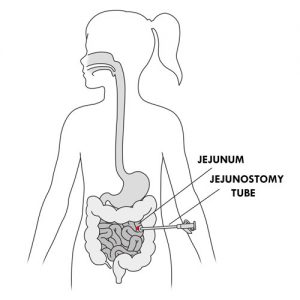
- Flexible tube inserted into the jejunum through a jejunostomy.
- Allows feeding directly into the jejunum.
- Allows medication to be administered directly into the jejunum, as recommended by the healthcare team.
- Mostly used in children who cannot be fed directly into the stomach.
- Can only be replaced by the healthcare team. If the healthcare team allows the parent to change the tube, they provide the necessary training.
- The choice between a nasal tube, button or long enterostomy feeding tube and the location of that tube in the digestive system (stomach, duodenum, jejunum) depends on several factors that the healthcare team considers when making their decision; for example:
- the duration of enteral feeding,
- the condition of the child,
- the child’s ability to tolerate food in the stomach,
- the condition and functioning of its digestive system,
- the presence or absence of significant problems with gastric reflux.
Buttons are often installed in children. They have the advantage of being comfortable and safe.
- A urinary Foley™ catheter (which is a long, flexible tube) can be temporarily placed in the stoma only after 6 to 8 weeks after surgery (or other length of time as recommended by your healthcare team) to prevent it from closing if:
- the gastrostomy balloon button or tube is accidentally removed and no other replacement button or tube is available to replace it,
- the parent is unable to replace the gastrostomy balloon button or tube,
- another type of button or long enterostomy feeding tube breaks or is accidentally removed.
The catheter must be secured after installation.
The child can be fed through the urinary catheter, if recommended by the healthcare team, while waiting to have the urinary catheter replaced with a button or an enterostomy long tube.
Discuss this possibility with the healthcare team depending on your child’s condition.
- The urinary Foley™ catheter consists of different components:
- an external part visible on the belly, composed of:
- a port and a balloon fill valve,
- a port that allows the administration of food and medication,
- an internal part in the stomach or small intestine, composed of:
- a balloon to hold the tube to the wall of the stomach or intestine and prevent it from moving,
- the end of the catheter is open to allow the nutritional formula to pass through.
A plug should be placed over the catheter opening between feeding sessions to prevent leakage.

- The child may receive water, hydration fluids, breast milk, fortified breast milk, infant formula, nutritional formula (or enteral formula or feeding or gavage solution) or liquefied food through the tube or button. Medications can also be given in liquid form this way.
- The nutritional formula is specific to each child. The healthcare team chooses the formula that is best for the child, taking into account the child’s nutritional needs, age, diagnosis, health condition and parental preferences.
- The formula contains mainly water, protein, sugars, fats, vitamins and minerals. The formula can be in liquid form or thicker (eg, purée), depending on the child’s needs.
- The healthcare team also recommends the appropriate format for the preparation of the nutritional formula:
- ready-to-serve: no need to add water or other ingredients, unless the healthcare team advises otherwise; the most convenient and easy-to-use format, but often the most expensive;
- liquid concentrate: should be diluted with water as directed; can be used to prepare a higher calorie formula as directed by the healthcare team;
- powder: more readily available but takes longer to prepare; can be used to prepare a higher calorie formula, as directed by the healthcare team; can be stored longer; more economical.
- The healthcare team provides instructions for the preparation of the formula, if applicable. The team provides information about the amount to be fed daily and helps the parent establish the best feeding schedule.
- As a child’s nutritional needs change over time, the healthcare team recommends the necessary adjustments to the type and amount of milk or formula to promote growth and good health.
- Nutritional formula, milk or water is administered according to the method and modality required by the child’s condition. This varies (see table below) depending upon:
- type of button or tube used,
- reason why the child requires enteral feeding,
- how often the child should be fed (schedule),
- duration of each feeding session and how well the child tolerates enteral feeding.
The important thing is that the child receives the nutrients needed for energy and growth.
NOTE: For ease of reading the rest of the text, the word (nutritional) “formula” also includes “breast milk”, “fortified breast milk” or “infant formula”.
METHODS OF ADMINISTRATION OF THE NUTRITIONAL FORMULA
By push
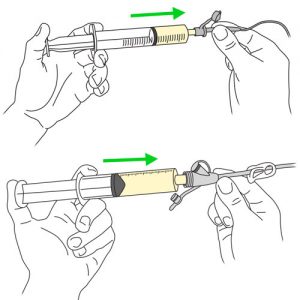
- The formula is “pushed” slowly with a feeding syringe into the tube or into an extension set attached to the feeding button.
- This method is used for bolus feeding and medication administration.
By gravity
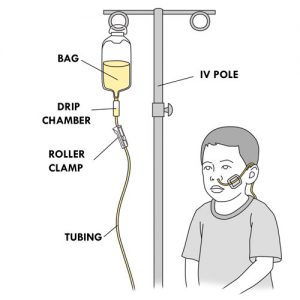
- The formula is poured into a bag connected to a tubing.
- The bag must be suspended at a height above the child’s head (eg, on an IV pole).
- The formula flows by gravity down the tubing through a drip chamber.
- The tubing from the bag is connected to the feeding tube or to an extension set attached to the feeding button.
- A roller clamp on the tubing adjusts the flow rate (or administration rate) of the formula.
- This method is used for bolus feeding.
- This method can be used as an alternative if the pump is not functioning.
By enteral feeding pump
(eg, Kangaroo™ ePump, Kangaroo™ Joey, Kangaroo™ Connect)
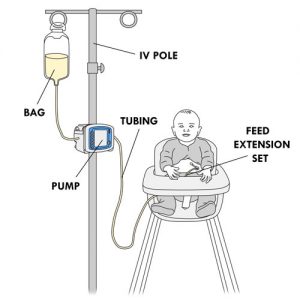
- The formula is poured into a bag connected to tubing.
- The tubing is inserted into an enteral feeding pump connected to an electrical outlet or powered by a rechargeable battery.
- The bag and pump are suspended from an IV pole or placed in a special backpack.
- The tubing from the bag is connected to the feeding tube or an extension set attached to the feeding button.
- The pump controls the amount of formula dispensed and the flow rate.
- Several models of electronic pumps are available for use in the home.
- The pump method is used for bolus or continuous feeding.
MODALITIES OF ADMINISTRATION OF THE NUTRITIONAL FORMULA
Bolus (or intermittent)
- Feeds are several times a day, over short periods of time, often during normal meal times.
- Depending on the child’s specific needs, can be used as a meal replacement or as a supplement to a meal taken by mouth.
- Each session lasts an average of 20 to 30 minutes (like the usual duration of a meal), depending on the amount to be given and the child’s tolerance. The child’s condition may require longer sessions (one hour or more).
- Bolus feeding cannot be given in the jejunum.
- Possible with the push, gravity or pump method of administration.
Continuous
- Feeds run continuously at a regular pace for the prescribed number of hours/day.
- Feeding may run throughout the day or night without interruption.
- Mostly used with the pump delivery method.
- Recommended for a child who:
- has difficulty tolerating large amounts of formula at a time (does not tolerate bolus meals),
- has slow stomach emptying,
- needs a specific amount of formula in a given period of time,
- is fed directly into the jejunum.
Bolus and continuous
- Allows mixed administration of the formula (eg, bolus during the day and continuously during the night).
- The material used for enteral nutrition (tube, button, adapter, connector, feeding bag with tubing, extension set, syringe, etc.) is reserved exclusively for this use.
- Refer to your healthcare team for:
- formula preparation instructions, if applicable,
- the amount of formula to be administered,
- the appropriate method of administration,
- the relevant administration modality,
- the flow rate of the formula, if applicable,
- the best feeding schedule for your child,
- the specificities related to the administration of medications.
Your healthcare team is available to supervise the care provided to your child, ensure the proper functioning of equipment and make recommendations to you as needed.
Refer to your healthcare team if the equipment used for your child at home is different from what is described in this section or in the methods of care.